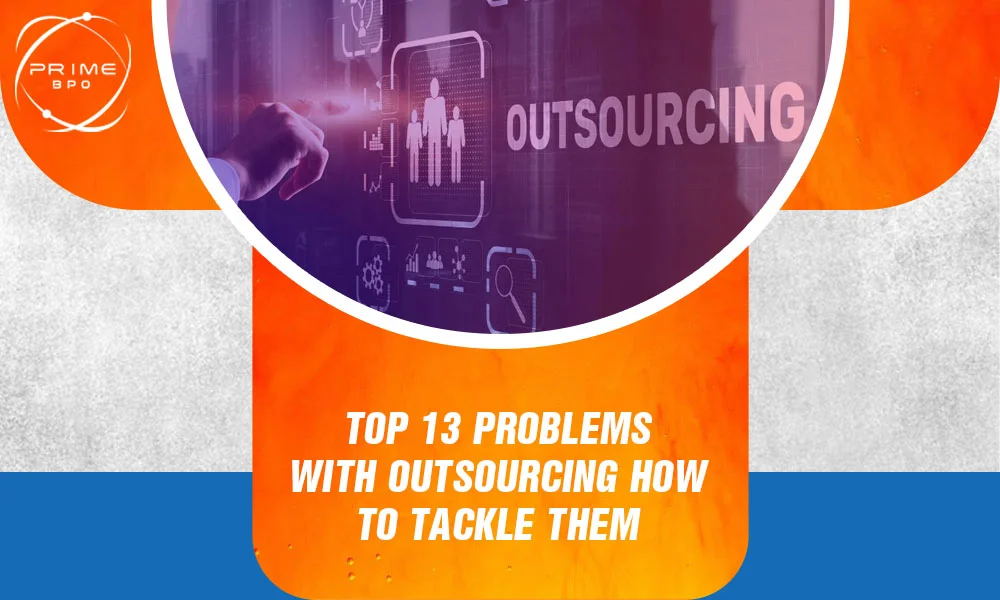Outsourcing has transformed how businesses function, offering various advantages such as cost savings and access to specialized skills. However, successful outsourcing comes with its share of challenges and you may have to face various problems with outsourcing.
Businesses encounter various obstacles, including communication breakdowns and security risks, which can hinder progress and affect profitability. In this comprehensive guide, we will explore the top 13 problems with outsourcing and present practical solutions to address them.
Whether you're new to outsourcing or seeking to enhance your current practices, this guide will provide you with the knowledge and strategies necessary to navigate the intricate world of outsourcing and attain your business goals. So, let’s get started!
Top 13 Problems with Outsourcing
Outsourcing has revolutionized modern business, offering cost savings and specialized skills. However, outsourcing issues and concerns like communication gaps and security risks require strategic solutions for success. Let’s discuss some of the problems with outsourcing along with their solutions:
1- Lack of Communication
Effective communication is vital for successful outsourcing, yet differences in language, culture, and time zones can lead to misunderstandings, delays, and even project failures. With clear and open communication channels, it's easier to ensure that both parties are aligned with project goals and expectations.
Solution
Establish robust communication protocols from the outset to overcome this challenge. Use project management tools to facilitate communication and collaboration, ensuring that all stakeholders are informed of project progress and updates. Additionally, provide language and cultural training to team members to bridge communication gaps and foster a more inclusive and cohesive working environment.
2- Quality Concerns
Maintaining consistent quality standards across geographically dispersed teams can be challenging. Differences in work culture, standards, and expectations may result in subpar deliverables, leading to client dissatisfaction and potential damage to the outsourcing partner's reputation.
Solution
To mitigate quality concerns, implement robust quality assurance processes and standards. Provide comprehensive training to outsourcing partners to ensure they understand and adhere to your quality requirements. Regularly monitor and evaluate the quality of work delivered, providing feedback and guidance as needed to maintain high standards.
3- Time Zone Differences
Working across different time zones can lead to communication delays, coordination issues, and extended project timelines. This can impact the efficiency and effectiveness of the outsourcingpartnership, potentially leading to missed deadlines and project setbacks.
Solution
To address time zone differences, establish overlapping working hours where team members from both sides can communicate and collaborate in real-time. Utilize scheduling tools and project management software to coordinate tasks and meetings efficiently. Additionally, establish clear communication protocols to ensure that important information is shared promptly and effectively across time zones.
4- Security Risks
Outsourcing sensitive tasks can expose businesses to data breaches, intellectual property theft, and confidentiality breaches. Without adequate security measures in place, businesses risk compromising their valuable assets and exposing themselves to legal and reputational damage.
Solution
Implement stringent security protocols and best practices to protect sensitive information. Use encryption technologies to secure data in transit and at rest. Conduct regular security audits and assessments to identify and mitigate potential security risks. Additionally, ensure that outsourcing partners comply with your organization's security policies and standards to safeguard against security breaches.
5- Hidden Costs
While outsourcing can lead to cost savings, hidden expenses such as setup fees, training costs, and additional charges for revisions or scope changes can significantly impact the overall cost-effectiveness of the outsourcing arrangement.
Solution
For a solution, it is suggested to conduct a thorough cost-benefit analysis before entering into an outsourcing agreement. Negotiate transparent pricing structures with outsourcing partners, ensuring that all costs and fees are clearly defined and documented in the contract. Include provisions for unforeseen expenses and scope changes in the contract to avoid surprises down the line.
6- Lack of Control
Delegating tasks to external vendors may result in a perceived loss of control over the project, leading to anxiety and micromanagement tendencies. Without clear visibility and oversight, businesses may struggle to ensure that projects are completed according to their specifications and standards.
Solution
To address this challenge, establish clear project management processes and communication channels with outsourcing partners. Set clear expectations and deliverables from the outset, and regularly monitor and evaluate progress against these benchmarks. Foster trust and collaboration with outsourcing partners to build a strong working relationship based on mutual respect and understanding.
7- Cultural Differences
Cultural nuances can impact communication styles, work ethics, and decision-making processes, leading to misunderstandings and conflicts. Without a shared understanding of cultural differences, businesses may struggle to collaborate with outsourcing partners from different cultural backgrounds effectively.
Solution
To overcome cultural differences, provide cultural sensitivity training to team members and outsourcing partners. Encourage open dialogue and communication to address any cultural misunderstandings or conflicts. Embrace diversity within teams and leverage cultural differences as a strength to foster creativity and innovation.
8- Dependency Risks
Over-reliance on outsourcing partners can leave businesses vulnerable to disruptions, such as vendor lock-in, capacity constraints, or sudden contract terminations. Without a contingency plan in place, businesses may struggle to maintain operations in the event of a disruption.
Solution
To solve this problem of outsourcing diversify outsourcing partners and maintain in-house expertise for critical functions. Develop a contingency plan to address potential disruptions, including alternative sourcing options and backup arrangements. Regularly review and update your outsourcing strategy to ensure that it remains aligned with your business goals and objectives.
9- Lack of Scalability
Outsourcing arrangements that cannot adapt to changing business needs may hinder scalability and flexibility. Without a scalable outsourcing strategy, businesses may struggle to effectively respond to market dynamics and growth opportunities.
Solution
Choose outsourcing partners with scalable infrastructure and resources to address scalability challenges. Negotiate flexible contracts that allow for changes in scope and scale as needed. Regularly reassess your outsourcing requirements and adjust your strategy accordingly to ensure that it remains flexible and responsive to changing business needs.
10- Poor Vendor Management
Inadequate vendor management practices can lead to misunderstandings, missed deadlines, and underperformance. With effective vendor management, businesses may be able to maintain a productive and collaborative relationship with outsourcing partners.
Solution
To improve vendor management, establish clear performance metrics and expectations from the outset. Provide constructive feedback and guidance to outsourcing partners to help them improve their performance. Foster a collaborative working relationship based on mutual respect and trust, and regularly review and evaluate vendor performance against established benchmarks.
11- Legal and Regulatory Compliance
Navigating complex legal and regulatory landscapes across different jurisdictions can pose compliance challenges and legal risks. Without a thorough understanding of relevant laws and regulations, businesses may inadvertently violate legal requirements and face legal consequences.
Solution
Conduct thorough due diligence on outsourcing partners to ensure they comply with relevant laws and regulations. Seek legal counsel when necessary to ensure compliance with legal requirements. Establish clear contractual provisions regarding compliance and regularly review and update your outsourcing agreements to reflect changes in legal and regulatory requirements.
12- Loss of Intellectual Property
Sharing proprietary information with external vendors increases the risk of intellectual property theft or unauthorized use. Without adequate protection measures in place, businesses may risk losing valuable intellectual property to competitors.
Solution
To protect intellectual property, implement robust confidentiality agreements and non-disclosure agreements with outsourcing partners. Restrict access to sensitive data on a need-to-know basis, and monitor for any unauthorized use of intellectual property. Regularly review and update your intellectual property protection measures to address emerging threats and risks.
13- Integration Issues
Integrating outsourced processes or systems with existing infrastructure can be complex and time-consuming. Without proper planning and coordination, businesses may struggle to integrate outsourced components seamlessly, leading to inefficiencies and disruptions.
Solution
If you are facing this problem, plan for integration from the outset of the outsourcing arrangement. Involve IT specialists early in the process to identify potential integration challenges and develop a comprehensive integration plan. Conduct thorough testing to ensure that integrated systems function properly and address any compatibility issues promptly.
These are some of the problems with outsourcing you may have to face while outsourcing your business. But don't worry, as we also suggest the best possible solution along with all the problems with outsourcing.
Conclusion
Outsourcing offers numerous benefits for businesses seeking to streamline operations, access specialized expertise, and drive efficiency. However, it's essential to be aware of the problems with outsourcing along with the potential challenges of outsourcing and proactively address them to ensure successful outcomes.
By implementing the solutions outlined in this guide and fostering strong partnerships with outsourcing vendors, businesses can overcome obstacles and unlock the full potential of outsourcing initiatives.
Frequently Asked Questions (FAQs)
1- How can businesses ensure effective communication with outsourcing partners?
Businesses can ensure effective communication with outsourcing partners by establishing clear communication protocols, using project management tools, and providing language and cultural training.
2- How can businesses overcome time zone differences when working with outsourcing partners?
Businesses can overcome time zone differences by establishing overlapping working hours, utilizing scheduling tools and project management software, and implementing clear communication protocols.
3- What security measures should businesses implement to protect sensitive information when outsourcing tasks?
Businesses should implement stringent security protocols and best practices, use encryption technologies, conduct regular security audits and assessments, and ensure compliance with security policies and standards.
4- How can businesses avoid hidden costs associated with outsourcing?
Businesses can avoid hidden costs by conducting a thorough cost-benefit analysis, negotiating transparent pricing structures, and including provisions for unforeseen expenses and scope changes in the contract.
5- What steps can businesses take to maintain control over outsourced projects?
Businesses can maintain control over outsourced projects by establishing clear project management processes and communication channels, setting clear expectations and deliverables, and fostering trust and collaboration with outsourcing partners.






